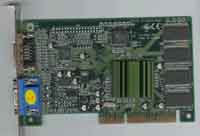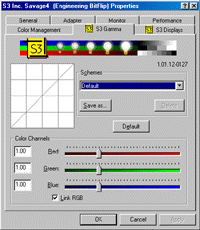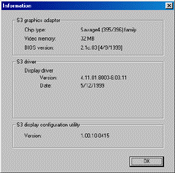
Original Link: https://www.anandtech.com/show/327
 Founded
in 1984, Gainward started out making video cards in Taipei, Taiwan. Since then,
they've grown rapidly and have worked with almost every major video chip manufacturer.
Not many had heard of Gainward, partially due to their large OEM focus, but
many of the "generic" video cards you find are in fact made by Gainward.
Ever seen a CARDEXpert board? That's Gainward. Actually, they also do a lot
of OEM manufacturing work for larger, better known video card manufacturers.
They won't say who, but rest assured that the list includes some of the most
famous video card manufacturers around.
Founded
in 1984, Gainward started out making video cards in Taipei, Taiwan. Since then,
they've grown rapidly and have worked with almost every major video chip manufacturer.
Not many had heard of Gainward, partially due to their large OEM focus, but
many of the "generic" video cards you find are in fact made by Gainward.
Ever seen a CARDEXpert board? That's Gainward. Actually, they also do a lot
of OEM manufacturing work for larger, better known video card manufacturers.
They won't say who, but rest assured that the list includes some of the most
famous video card manufacturers around.
A few weeks ago AnandTech took a look at our first Gainward products - a couple of motherboards, the i440BX 6IBA and i440ZX 6IZB. Those two boards didn't fare all that well, so we decided to check out the video card side of Gainward's business. As mentioned above, this is where they got it all started and where they are by far more successful.
Specifications
Here are the full specs for the S3 Savage4 from S3. Since the Gainward is a straight up reference design, the general Savage4 specs apply.
High-Performance 2D/3D/Video Accelerator
- Floating point triangle setup engine
- Single cycle 3D architecture
- 8M triangles/second setup engine
- 128-bit rendering pipeline
- 110M pixels/second trilinear fill rate
- Full AGP 4X/2X, including sideband addressing and execute mode
- S3 DX6 texture compression (S3TC)
- Flat panel desktop monitor support
- High quality DVD video playback
3D Rendering Features
- Single-pass multiple textures
- Hardware bump mapping
- Full scene anti-aliasing
- Anisotropic filtering
- 8-bit stencil buffer
- Single cycle trilinear filtering
- 32-bit true color rendering
- Specular lighting and diffuse shading
- Alpha blending modes
- MPEG-2 video textures
- Vertex and table fog
- 16- or 24-bit Z-buffering
- Sprite anti-aliasing, reflection mapping, texture morphing, shadows, procedural textures and atmospheric effects
Motion Video Architecture
- High quality up/down scalar
- Planar to packed format conversion
- Motion compensation for full speed DVD playback
- Hardware subpicture blending and highlights
- Multiple video windows for video conferencing
- Contrast, hue, saturation, brightness and gamma controls
- 60MHz VIP video port allows HDTV resolutions
- Digital port for NTSC/PAL TV encoders
High Speed Memory Bus
- 110/125 MHz memory interface
- 2 to 32 MB frame buffer
- 1Mx16 or 2Mx32 or 4Mx16 SDRAMs
- SO-DIMM memory upgrade
- Block write support
2D Acceleration Features
- Highly optimized 128-bit graphics engine
- Full featured 2D engine for acceleration of BitBLT, rectangle fill, line draw, polygon fill, panning/scrolling and hardware cursor
- 8, 16, and 32 bpp mode acceleration
Flat Panel Desktop Monitor Support
- 24-bit digital interface for flat panel encoders
- Auto-expansion and centering for VGA text and graphics modes
- Support for all resolutions up to 1280x1024
Full Software Support
- Drivers for major operating systems and APIs: [Windows. 9x, Windows NT 4.0/5.0, Windows 3.x and OS/2. 2.1/3.0 (WarpTM), Direct3DTM, DirectDrawTM and DirectShowTM, OpenGLTM ICD for Windows 9x and NT]
- Comprehensive SDK, utilities and ISV tools
- ISV and bundling programs
Additional Features
- 300MHz RAMDAC with gamma correction
- I2C serial bus and flash ROM support
- ACPI and PCI power management
- Hardware and BIOS support for VESA timings and DDC monitor communications
- PCI 2.2 bus support including bus mastering
- 27x27mm PBGA with 336 balls
- 2.5V core with 3.3V/5V tolerant I/O
As you can tell by the specs, the Savage4 already features a fully functional OpenGL ICD under Windows 9x and NT, a definite plus. The 300MHz integrated RAMDAC is seemingly standard among the big four manufacturers, 3dfx, NVIDIA, Matrox and S3, and it provides for an increasingly sharp 2D picture in comparison to the old Savage3D.
The Card
Since video chipset manufacturers usually offer up reference board designs, and motherboard chipset manufacturers don't, it stands to reason that designing a video card is a lot easier than a motherboard. This is apparent in Gainward's strict use of an S3 Savage4 reference PCB design. This keeps costs down by reducing engineering costs. And in this case, the reference design make efficient use of space, which further cuts down on costs.
The board itself is just long enough to fit in an AGP slot, so there's no need to worry about interference from tall motherboard components. AnandTech's sample featured S3's 86C397 Savage4 Pro backed up by 32MB of 8ns/125MHz MIRA SDRAM. The Savage4 chip itself is adorned with an interesting green heatsink - one that's actually fairly common on Gainward graphics cards. It is sort of a semicircle in shape and does a good job of cooling the Savage4 Pro, allowing it to overclock stabily to 135/135 for about a 20% increase in performance.
There has been some confusion regarding the clock speed of the various Savage 4 versions, even by us here at AnandTech. This was recently cleared up by Paul Crossley of S3 in an e-mail sent to Sharky Extreme. What it comes down to is that the Savage4 Pro is spec'ed at 110/125MHz (core/memory). The Savage4 Pro Plus is the chip used on the Diamond Stealth III S540 and is intended to be clocked at 125/143. The 86C397 on the CARDEXpert SG4 AnandTech received is clocked as S3 says it should be - at 110/125. Gainward also offers models based on all available variations of the Savage4 chipset. Expect everything except the exact performance numbers and overclocking results to apply to the other Gainward CARDEXpert SG4 models.
The 2D image quality, as briefly alluded to above, is quite strong courtesy in part by the integrated 300MHz RAMDAC of the 0.25-micron Savage4 chip. The other half of the 2D image quality equation comes from the design of the card itself. For the SG4, that all equates to quite good 2D image quality for resolutions up to 1600x1200.
The review sample AnandTech received featured a digital flat panel out on the back of the card. The interface follows the DDWG (Digital Display Working Group) standard and supports resolutions up to 1280x1024. Remember that this port is optional, so make sure you specify it when ordering if you want to take advantage of it.
Drivers/Software
The same way Gainward chose a reference PCB design, the CARDEXpert SG4 also uses 100% straight up reference drivers. Gainward has done this in the past with their video cards, and as long as the chipset manufacturer, S3 in this case, continues to release updated drivers to the public, there's no problem with relying on reference drivers. Of course, you don't get some of the cool tools and utilities offered by a custom driver set like Diamond's InControl Tools 99, but there are always freeware utilities out there that will accomplish most of the same tasks.
The standard S3 reference drivers do provide the basics - gamma correction, TV-Out control, and driver information. Pretty bare bones compared to some other manufacturers, but it will get the job done. There's no VSync toggle or control over any other 3D features, but they can of course be toggled via registry keys. However, that can be a pain if you like to play around with things all the time, and that's where a utility like Powerstrip can really come in handy.
A major concern here is that one of the biggest problems with the original Savage3D was the driver situation. They were always fairly immature and not too stable. Fortunately, S3 has learned from their Savage3D mistakes and has made great strides with their drivers for the Savage4. With the Savage4 core based fairly closely on the Savage3D, S3 got quite a head start in the driver writing process. That's translated into fairly stable 2D, D3D, and OpenGL driver support. They've always had a full ICD and that hasn't changed here. S3 Texture Compression (S3TC) is of course supported again on the Savage4 and will be incorporated into DirectX eventually. There are, however, still a few image quality issues, even with the latest beta drivers (version 8.03.11 dated 5/14/99). Again, these are S3 issues since the Gainward uses a reference PCB and reference drivers.
With Gainward's focus clearly on OEM's, it's no surprise that there is no game bundle with the CARDEXpert SG4. For some this is a welcome cost saving measure, but others would prefer to have some games to show off on a brand new card. Each person will have to make the call for himself on this touchy subject.
The Test
AnandTech tested a Gainward CARDEXpert Savage4 card clocked at the S3 spec'ed 110/125. For a complete set of benchmarks, see AnandTech's comprehensive S3 Savage4 Review. AnandTech's Slot-1 test configuration was as follows:
- Intel Intel Pentium II 400 and Intel Pentium II 266
- ABIT BH6 i440BX Motherboard
- 64MB of Memman/Mushkin SEC Original SDRAM was used in each test system
- Western Digital 8.4GB Ultra ATA/33 HDD
- Microsoft Windows 98 SE
- DirectX 6.1a
- S3 Savage4 Reference Drivers 8.03.11 (5/14/99)
The benchmark software used was as follows:
- id Software's Quake 2 Version 3.20 using demo1.dm2 and 3Finger's crusher.dm2
- Monolith's Shogo using 3Finger's RevDemo
Each benchmark was run a total of three times and the average frame rates taken. Vsync was disabled.
OpenGL Performance - Pentium II/400



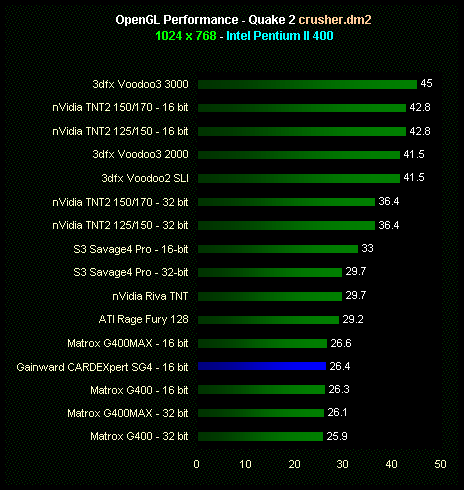
OpenGL Performance - Pentium II/266

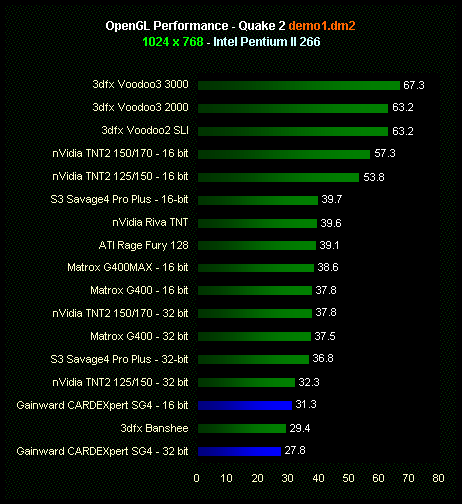
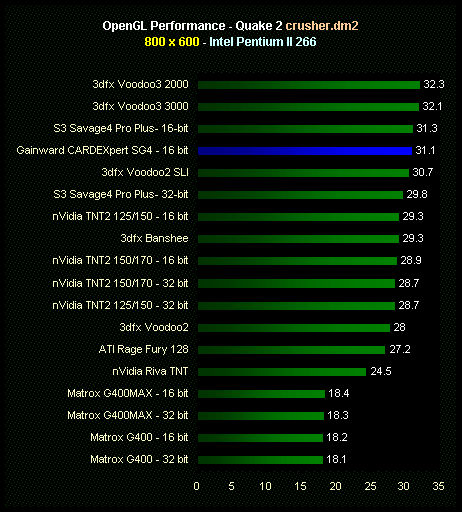
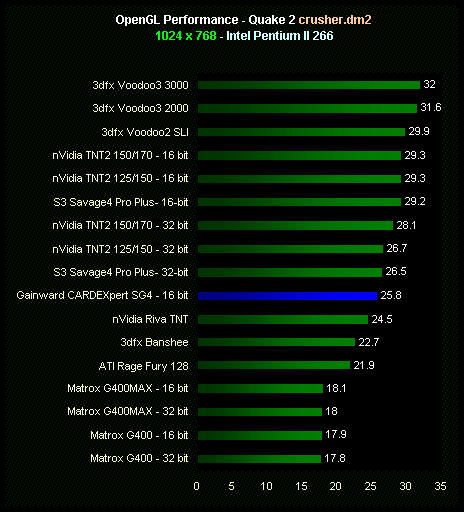
Direct3D Performance
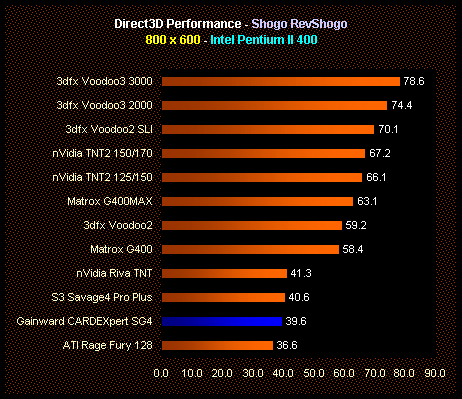
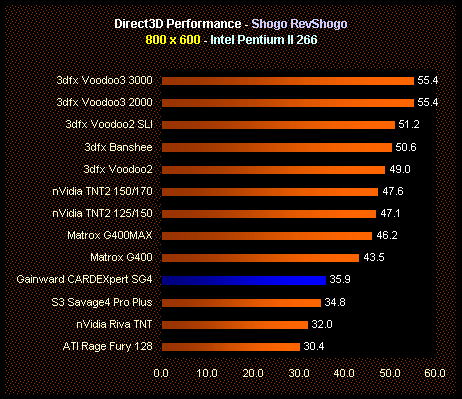
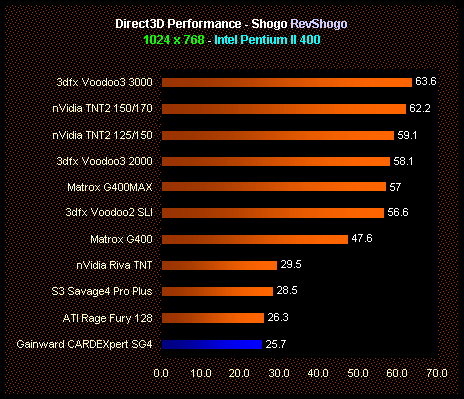

Performance Notes
Under both OpenGL and Direct3D, there is about a 10% drop in performance when 32-bit rendering is enabled - quite small in today's 3D accelerator market. Performance up to 800x600 resolutions is generally pretty good and quite playable, but a fairly large drop off is noticed when switching to 1024x768 and above. For the most part, the performance is quite close to that of the original TNT. The Quake 2 Crusher scores are quite interesting, especially on the Pentium II/266 where the Savage4 is at the top of the pack lagging only behind the Voodoo3 in 800x600.
Users with lower end CPU's will be happy to see that the performance with a Pentium II/266 nearly matches that of a Pentium II/400. The flip side is that users with high end CPU's should probably opt for something with a little more power than the Savage4.
It's also interesting to note that the Gainward CARDEXpert SG4 came out ahead of the higher clocked Savage4 Pro Plus used on Diamond Stealth III S540 in Shogo at 800x600 on a Pentium II/266. This is most likely due to the use of newer drivers on our Gainward card that simply were not available at the time of the Diamond review.
Conclusion
Our first look at a production Savage4 card gave us a good idea of what the Savage4 could do. Gainward's CARDEXpert SG4 brings no surprises to the party - just a straight up reference Savage4 Pro with decent overclockability, good 2D output, and a price that's hard to resist. And this is exactly what the Savage4 is supposed to be - a budget card for systems with not enough CPU horsepower to keep a TNT2 or Voodoo3 running optimally. However, the drivers are still a little weak, and until S3 can prove to us that they can write good drivers (by putting out good drivers), a better pick may be a TNT card - those prices are dropping rapidly in light of the TNT2, Voodoo3, and G400.
The hardest part may be finding the Gainward - often times it's considered a generic, and picking among a huge number of generics can be tricky. Fortunately for Gainward, the CARDEXpert name is becoming more and more popular, so don't be surprised if you see it show up in your local computer shop or mail order price lists.

